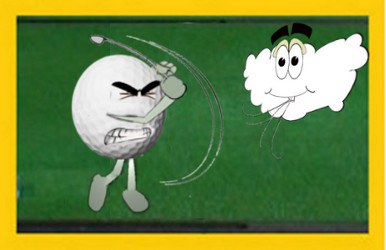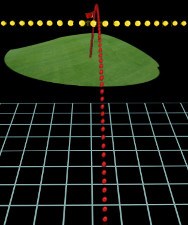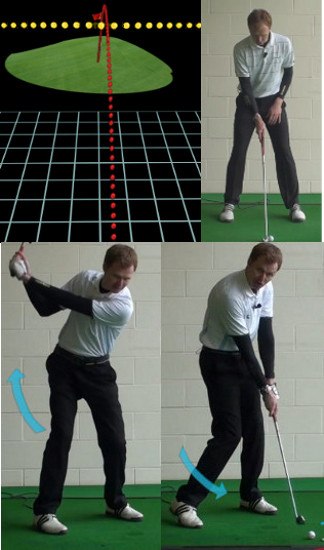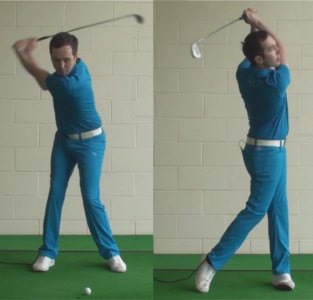
If you have a habit of struggling on windy days, your iron shots getting tossed hither and yon on the breeze, you could be making a common mistake – hitting the ball too hard.
Playing into or across a strong wind, the natural tendency is to swing harder. Many players fail to adjust their club selection as well, hitting their normal club for the distance (say, an 8-iron for a 150-yard shot) and giving it a little extra juice.
Here's the problem: Hitting the ball harder causes it to spin more; the more spin, the greater the wind's effect; the more loft on your club, the higher the ball flies and the more it spins. Hence, the ball flutters like a butterfly and drops well short of the green.
The solution is simple. Take more club and swing easier.
Let say you've got 8-iron yardage into a strong headwind. Grab your 6-iron and make a smooth, slightly abbreviated swing. There's no need to add extra hit at the bottom. The club's reduced loft will cause the ball to fly lower, while your easy swing will limit backspin. The ball will penetrate rather than balloon, fly straighter, and carry all the way to the target.
Just remember this phrase: When it's breezy, swing easy. How hard is that?

Irons Flying Too High – Hitting Too Hard?
Most of the time, hitting the ball high into the air is a good thing. High golf shots allow you to carry the ball great distances, and they also allow you to stop the ball quickly when it lands. However, as with anything else, you can get to a point where you have too much of a good thing. If you are hitting your irons too high, you might find that you are actually losing distance, and you are probably having trouble playing well in windy conditions as well.
So, how do you correct for this problem? Believe it or not, one of the best ways to bring your iron ball flight back down to earth is to not swing so hard. High swing speeds tend to toss iron shots high into the air, so you can effectively bring the ball back down simply by swinging a little softer. You don't have to swing at 50% effort, of course, as you still want to swing hard enough to hit the ball a decent distance. However, by swinging somewhere in the range of 80% effort, you should be able to achieve a trajectory that is high enough to give you ample distance, yet low enough to allow you to keep control over the golf ball as it flies.
Unfortunately, most amateur golfers only know one speed when they get a club in their hands – full speed. If you are anything like most of the other average players in this game, you probably swing as hard as you can each and every time you stand over the ball. And, in some cases, that isn't necessarily a bad thing. Distance can be tremendously helpful in golf, so swinging hard is a good way to move the ball down the fairway when you are wielding a driver. However, when the club in question is a short iron rather than a driver, you would likely be better off to turn down the volume on your swing a bit. Even taking just 10 or 20% of the effort out of your swing will go a long way toward improving your ability to control the flight of the ball. It takes some self-control to make this strategy work, but you will likely fall in love with the results after just a few swings.
In addition to lowering the ball flight that you see from your irons, swinging a little softer will have a number of other positive effects on your game. For one thing, you should find that you are making solid contact with the ball more frequently with a softer swing. Since you aren't going all out after the ball, you should do a better job of keeping your head still and holding your balance – two things that are going to help you find the sweet spot. Also, a softer swing will help you to develop feel in your game, and feel is something that can pay off all around the course. You never know what kind of shots you are going to face during the average round of golf, and it is your feel that helps you to deal with the tricky shots you may not have practiced on the range.
All of the content included below is written from the perspective of a right handed golfer. If you happen to play left handed, please be sure to reverse the directions as necessary.

Why Does a Hard Swing Send the Ball Higher?
To get started on this topic, let's quickly take a look at why it is that a golf ball is likely to fly higher with a hard swing as compared to a soft swing. Simply put, it all comes down to spin rate. While the loft on your clubs is what is going to help the ball get up into the air initially, it is the spin that is going to keep the ball in the air – and help it to climb higher, as well. So, there is usually a direct correlation seen between spin rate and the height of a shot. Of course, there is also a correlation between your swing speed and your spin rate, especially when hitting iron shots. So, in the end, a shot that is struck with a pitching wedge at one speed is going to have a higher spin rate than a shot which is struck with the same wedge, in the same manner, with a lower swing speed.
If you are at least somewhat experienced in the game of golf, you have probably seen this effect play out in front of you once or twice. Often, golfers will notice how high the ball can fly when they hit a shot with a sand wedge from the fairway into the wind. With the help of the wind to push the ball even higher, this kind of shot can reach incredible heights – and it will almost always come down short of the target. A big part of the height that is achieved by this kind of a shot can be attributed to the way the spin works with the wind to create lift. Rather than knocking the ball down, the wind will actually push it higher and higher. It is for this reason that you want to play the ball low when heading into the wind – you have to avoid giving the wind the chance to push up on your shots, causing them to fall short of the green.
It should be mentioned that there are other factors in play when it comes to the height of your shots aside from just swing speed. A few of those important variables are listed below –
- Your golf ball. The golf ball you decide to play is going to have a lot to do with how high your shots fly once they leave the club face. If you are using a 'tour' level golf ball, you will get plenty of spin on most of your shots, as long as you make decent contact. Therefore, the ball is likely to fly high when you strike a tour-style golf ball cleanly. However, the same cannot be said for a distance ball. If you have purchased some cheap golf balls which only cost around $10 - $15 per dozen, those balls are going to offer very low spin rates due to their construction. That means you won't get a ton of lift even when you hit your irons very hard, so the ball flight will be pretty flat in the end. Finding the right ball for your game is one of the key equipment decisions that you need to make, so test out a few different options before settling on a winner.
- Your clubs. Golf clubs that are in relatively good condition, with grooves that are free of grass and debris, are going to spin the ball at a higher rate than old, worn out, dirty clubs. You need the grooves on the face of the club to 'grab' onto the golf ball at impact in order to raise your spin rate effectively. While the ball plays a bigger role in this equation than does the club, it is still important to have clubs which feature relatively fresh grooves and a clean face.
- The quality of impact that you achieve. There is nothing like making clean impact with the ball when it comes to generating spin. You simply aren't going to get much spin on your shots when you make poor contact, such as if you hit the ball a bit thin or a bit fat. Players who are having trouble hitting the ball with much spin are almost always going to need to work on their quality of contact in order to improve on that issue.
Of course, if you are currently hitting your irons too high, you don't need to work on adding more spin to your shots. However, it is important to at least understand how spin is generated, as nearly every shot that you hit in this game is going to be affected in some way by spin (except for your putts, of course). Now that you have a good understanding of where spin comes from, we can move on to the task at hand of bringing your high ball flight back down closer to the earth.

Hitting Softer Iron Shots
If you are used to simply trying to hit each of your shots as hard as possible, it might be a little difficult at first to hit your iron shots a bit softer. However, this is a skill that you can develop over time, and there is every reason to believe you can become quite adapt at this type of iron shot with some practice. In fact, after you learn how to hit softer iron shots, you probably will have no interest in going back to hitting hard shots once again. The control and precision that you can enjoy with a softer swing in your iron game is something that is going to allow you to set up birdie chances all day long. Who would give that up just to hit the ball harder and higher?
To make the move from full-out iron swings to taking a softer approach to your game, use the tips below.
- Choke down slightly on the grip. The first adjustment that you are going to make is to choke down slightly on the grip of your irons. By slightly, we only mean an inch or maybe two at the most – you really don't want to choke down very far. If you come down the grip too far, you are going to have trouble producing enough speed to hit your clubs a reasonable distance. By choking down just slightly, you will naturally take a bit of speed out of your swing. Even if this is the only step you take, you will already be on your way toward hitting lower iron shots.
- Use plenty of club. This is the tip that usually throws most average golfers for a loop. It wouldn't seem like your club selection could have anything to do with the height of your shots, but in fact those two points are very much related. When you pick a club, you are also inherently picking the kind of shot you wish to play at the same time. For instance, if you pick an iron that is only going to reach the target if you swing at maximum power, you have already made up your mind on how you are going to swing. That club won't reach the green with a softer swing, so you have to go flat-out just to get anywhere near the putting surface. You can avoid putting yourself in that position, however, by taking more club. Choose one more club than you would take on most of your iron shots and swing softer to bring the ball down at the right distance. Knowing that a hard swing could send the ball over the green, you will have all the motivation you need to take something off of the shot.
- Quiet your hands through the hitting area. Aggressive hands at impact are another way to add spin to your shots, and add height to your trajectory as a whole. While it is okay to use your hands aggressively on some shots that you face – such as greenside bunker shots – too much hand action is going to get you in trouble in the iron game. Instead of using your hands to propel the club through the ball, focus on using the rotation of your body to do the job. Keep your hands relatively quiet while your hips turn on through toward the target. You will be left with a swing that is well-controlled, balanced, and able to produce the same kinds of shots time after time.
A big part of learning how to hit the ball softer simply comes down to practicing this skill. During your next trip to the driving range, work on hitting all of your iron shots at something less than full power. Instead of aiming at targets that require big swings to reach with the club you are holding, pick shorter targets and swing softly throughout your practice session. You will likely be the only person on the range working on these kinds of softer shots, and you will also be the only person on the range who is really getting any better.

Bringing Short Irons in Low
Realistically, very few amateur golfers are going to need to lower their trajectory with long irons. It is hard enough to get long iron shots off the ground at all, let alone hitting the ball so high that it becomes a problem. For long iron shots, you should be able to swing away without any fear of creating too much spin or too high of a trajectory.
In the world of short irons, however, it is a totally different story. Many players can and do hit their short irons too high, which makes it hard to knock the ball close to the hole on a consistent basis. If you would like to become more accurate with your short iron game, bringing your trajectory down is something that you need to do in short order.
The tips that we listed above on the topic of swinging softer certainly apply to your short irons just as they do to any other clubs. However, the tips below are points which are specific to playing short iron approach shots. As you work on learning how to bring the ball into the green with a low trajectory while swinging a wedge, be sure to keep these points in mind.
- Play the ball back in your stance. You probably could have figured this one out all on your own. When you are trying to play a controlled, low approach shot with a wedge, you want to start by moving the ball back in your stance. You certainly don't want to line it up all the way back by your right foot, but it should be somewhere roughly in the middle of your two feet. As you swing, don't lean back in an effort to help the ball get up off the ground – it doesn't need any help. Stay balanced, hit down through the shot, and watch the ball take a low flight directly toward the target.
- Flat left wrist. This point goes right along with the point in the previous section about keeping your hands quiet. As you approach impact with a short iron, do your best to keep your hands quiet through the hitting area, including keeping the back of your left wrist flat at impact. Thinking about the positioning of your left wrist is one of the best ways to control your ball flight, as that left wrist is going to mirror the position of the club face at the bottom of the swing. If your wrist flips into a cupped position at the bottom of the swing, the club face is going to flip up as well. Drive through the shot while thinking about holding your flat left wrist position and any excess height should be successfully taken out of your wedge shots.
- Get onto your left leg. By the time you reach impact with this short iron swing, a majority of your weight should have moved onto your left leg. You don't want to slide left in order to get into that position – rather, you should be rotating toward the target in the downswing, which will move you left gradually as you turn. Finding your weight on your left leg is key toward the goal of hitting a low shot, as this is going to enable you to hit down through the ball. Countless amateur golfers struggle with this point, so make sure it is something that is a top priority in your practice sessions.
Between the six total tips that have been offered up in the two sections above, you should have no trouble producing lower golf shots almost immediately. Take a bit of time out of each of your practice sessions to work on softer, lower iron shots and your game should improve quickly in this area.

When You Need to Go High
The entire article has been dealing with what you need to do to control the trajectory of your iron shots. Hitting the ball too high can be a serious problem, and it can prevent you from playing your best. But what about those times when you need to hit the ball high? For example, if you have a tree in between you and the green, what do you do to add height to your shot intentionally?
Well, the first thing you need to do is to add loft to the club. At address, you are going to open the face of the club slightly to make sure it has as much loft as you can manage at impact. Then, you are going to move the ball slightly forward in your stance, placing it at least a few inches ahead of center. Also, you will want to widen your stance to promote great balance, as you are going to need to swing hard in order to generate the speed required to hit the ball high. As you would guess, all of these adjustments are going to lead to a shot that comes up short of its normal distance. So, while you might be able to get over an obstacle in front of you, it is going to be necessary to adjust your aim to make sure you don't land in a bad spot.
Hitting the ball high in golf is something of a double-edged sword. It can be a great advantage to be able to throw the ball high up into the sky, but it can also work against you when those high shots get out of control. Work on applying what you have learned in this article to grow your ability to control the height of your iron shots on command. With the ability to hit the ball both low and high, you will soon have more options at your disposal when out on the course.





